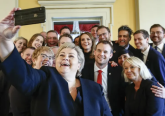
Nawaz Sharif, the leader of the Pakistan Muslim League, is back in power. Sworn in as prime minister on June 5th, for the third time since 1990, he has been recognized over the course of his political career as a principal challenger to the military’s supremacy in governing Pakistan. Indeed Mr Sharif’s proactive pursuit of peace with India became the primary reason for his forcible ouster from power by the army in October 1999 and he was subsequently imprisoned and exiled for intruding into what the army considers its exclusive foreign policy domain. But the tide of history has now turned back in his favour and he promises a ‘new chapter’ in the country’s relationship with India. ‘We will start from where we were interrupted in 1999’, he declared as soon as the PML-N won the May 11th elections.
Since his dealings with India precipitated his ouster from power 14 years ago, there is now a heated debate over the prospects of a fast-paced rapprochement with its southern neighbour. Sharif has already pledged to take some bold initiatives: improving trade, energy and transportation links; expediting the Mumbai terror investigations; establishing a commission of enquiry on the Kargil conflict (which had subverted the peace process with India, especially the February 1999 Lahore Declaration); and reigning in non-state actors such as Lashkar-e-Tayba, accused of committing terrorism against India. Indian leadership (from the majority in Congress and the BJP opposition) have wholeheartedly welcomed Mr Sharif’s return to power and his overtures towards India. For now at least, there is visible public optimism in both countries that perhaps the two traditional foes are finally well on their way towards a sustainable course of mutual peace.
What are the reasons for hope?
Most political commentators also believe things are looking up. They refer above all to Mr Sharif’s accommodative character and his pro-India track record. As a Punjabi with Kashmiri roots, he has enough national credibility to avoid suspicion of being too soft on India. Moreover, he has come to power with a significant public mandate, and after a long struggle in politics, he has learnt the right lessons, matured and mellowed.
Mr Sharif is well aware of the army’s red lines and the imperative for gradual change, leading many to believe that he will avoid adventurism in dealing with the top brass. His genuine efforts to make peace during his two premierships in the 1990s prove his goodwill towards India, including the design of a Composite Dialogue process in 1997, the initiation of back-channel negotiations and the ‘bus diplomacy’ that eventually led to the Lahore Declaration. Finally, as a successful pro-trade/investment industrialist, he is inherently pragmatic and aware of the great benefits of increased trade and investment dealings with India.
Pakistan’s current domestic political conditions are also perceived as largely conducive for improving Indo-Pakistani relations. First, the country has seen the first-ever transition from one elected civilian government to another, and high voter turnout, in spite of violence and threats against ‘secular’ parties by militants, further stabilized the fragile democracy. This is a necessary – albiet insufficient – pre-condition to resisting illegitimate military intrusion. Second, the PML-N won 126 out of 272 elected seats, a decisive victory that will allow it to form a stable government. This strong mandate, with executive powers limited by constitutional checks, will provide stability to the federal government and give it greater leverage in the civil-military struggle over India policy. Third, there exists across-the-board consensus among mainstream and regional political parties for intensifying dialogue with India, a course supported by public opinion and increasingly vocal peace lobbies in both countries. Fourth, Pakistan’s perennial economic crisis, reflected especially in acute energy shortage, has made better trade relations with India an absolute imperative. And finally, the army faces more pressing issues than India – Afghanistan post-2014, deteriorating relations with the US, the strangled economy and internal insurgencies. Its wariness about increasing economic losses and diplomatic isolation make it more amenable to improve relations with India. Rapid progress in ties with India during the former PPP-led government, especially Pakistan granting India the Most Favoured Nation (MFN) as a reciprocal gesture, could not have occurred without the army’s tacit approval.
Structural barriers to change
Such liberal hopes for foreign policy change are deeply embedded in the belief that individual and domestic factors have a major influence on the foreign policy behaviour of states – and Pakistan’s India policy is at the very heart of its overall orientation in international relations. But cases in other regions of the world and previous periods in Pakistan’s history suggest that political elites and institutions – especially in societies with strong patronage networks – are usually change-averse and bound by structural constraints. Among ‘enduring rivalries’, the Indo-Pakistani is one of the longest and one that has outlived generations of civilian leadership. Are, then, the conditions really ripe for Mr Sharif to deliver peace?
Theories of foreign policy change and stability suggest a complex set of carriers and barriers for different degrees of foreign policy change, ranging from mere modification and programme changes to goal alteration and an entire reorientation. What these studies demonstrate is that changes in individual leadership and democratization alone are insufficient drivers of change – in particular in such deadlocked environments such as in South Asia.
In addition to favorable individual and domestic conditions, an external shock in the system is needed, a disruptive event that makes leaders (of power-wielding institutions such as the army in Pakistan) revise their expectations and open up windows of opportunity. Productive third-party involvement designed to alter the confrontational foreign policy narrative as well as a structural environment that allows enough leverage for domestic decision makers (elected civilian leadership in Pakistan’s case) to implement and enforce new policies are also imperative for change to happen. On all these fronts, Pakistan scores low, thereby diminishing hopes that Pakistan undertakes a paradigm shift in its strategy toward India anytime soon. American or Chinese involvement may spark such paradigm policy shift in Pakistan, yet the track record shows both countries favouring cooperation with military regimes.
The structural environment is also not conducive for a strategic shift in Pakistan’s India-centric security paradigm to occur in the foreseeable future. Growing economic and military power asymmetry between India and Pakistan continues to fuel Pakistan’s insecurity dilemma. Balancing this asymmetry therefore remains a raison d´être and a guarantee for the army to stay on top of foreign and security issues. In addition, lingering territorial disputes such as Kashmir were not high on the election agenda, but remain unresolved and can lead to a sudden escalation of tension, as was the case in January. A final and more important barrier of change is the persistent role of the army: while the civilian government might have changed, the army has not. It has dominated politics, directly or indirectly, long enough to control core areas of foreign policy, particularly relations with India. Its India-centric security paradigm is justified on the basis of perceived or real threats from India, and perceptions of a hostile India are sustained by projecting Islamic ideology as the basis of Pakistan’s creation. From a structuralist standpoint, the army’s tacit acceptance of improved trade relations therefore reflects a ‘tactical retreat’ rather than a ‘strategic shift’.
Nothing guaranteed
The implications of such structural and ideological constraints are not deterministic, however, and under certain conditions the balance can shift in favour of foreign policy change. Much will still depend on the way Mr Sharif deals with the army. Factors such as security quagmire, economic crisis and regional isolation have deterred the army in recent years from intervention in politics and adventurism in the region. Thus, unlike the 1990s, Sharif has considerable room to manoeuvre and expand the scope of civilian power in domestic and foreign policy decision making. In the domestic sphere, how he tackles controversial issues such as PML-N’s links with banned religious outfits like Lashkar-e-Tayba may have a crucial impact on the dialogue with India, especially for securing a mutually acceptable settlement of Kashmir. Ensuring transparency in the national counter-terrorism approach and finding common ground with India in Afghanistan will be two key challenges.
Recognizing the urgency of these matters and their inextricable linkages to Indo-Pakistani relations can, in the medium term, contribute to building institutions in trade and politics that reduce insecurity, mistrust and ideological enmities and eventually show that gains trump increasingly painful losses. Either way, no rapid changes should be expected. Unforeseen circumstances as well as unfavourable outcomes of the parliamentary elections in India and leadership shift in the Pakistani army within the next months could quickly derail the rapprochement. But Sharif doesn´t even need to go all the way back to 1999 and can instead build on some recent progress. His previous initiatives of the back-channel negotiations and composite dialogue have been advanced under subsequent regimes and have already begun to pave the way for change—with or without the army’s consent.








1 Comment
Slight correction – Pakistan is yet to extend MFN, which is an euphemism for Normal Trading Relations, to India.